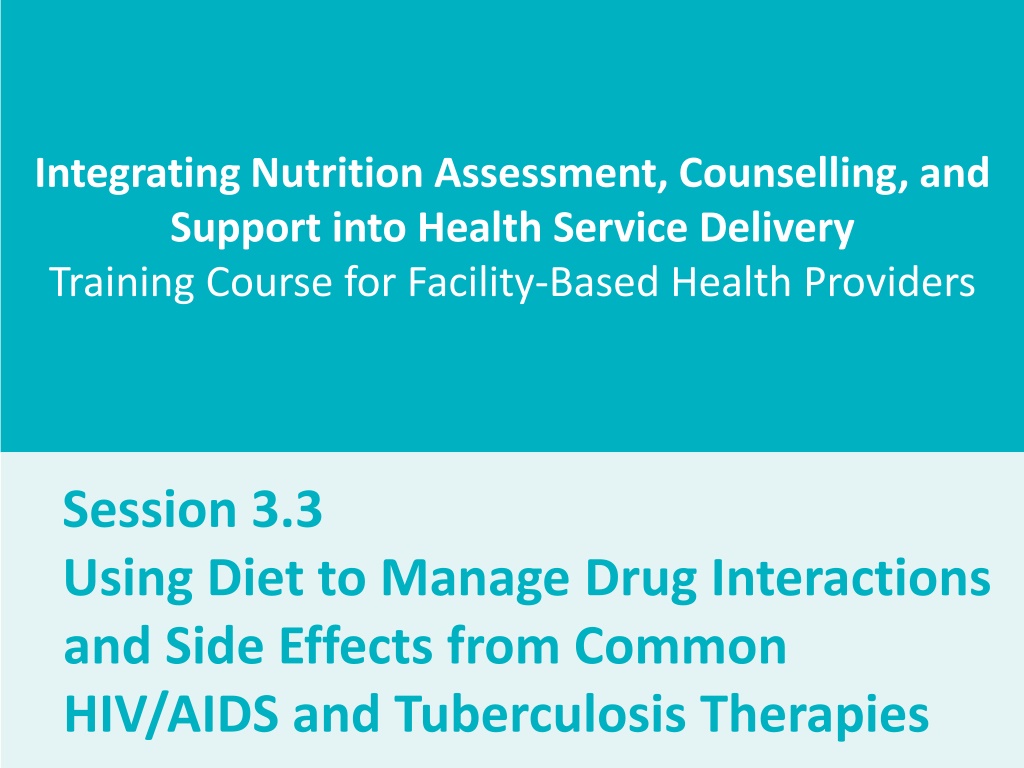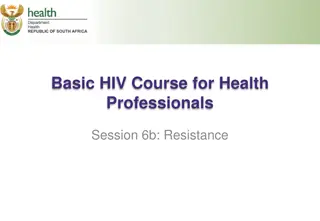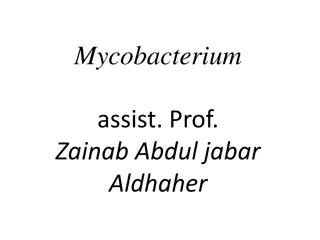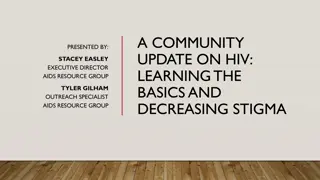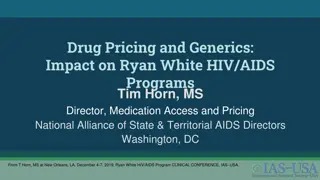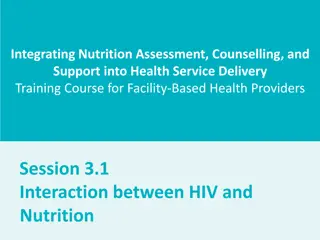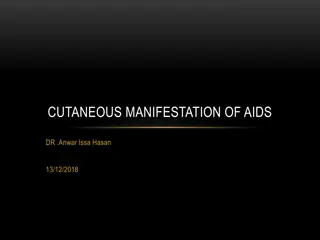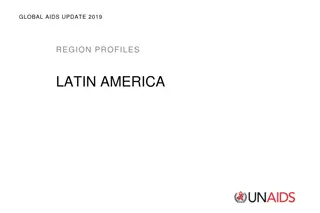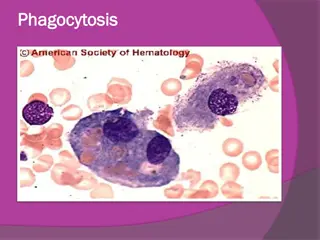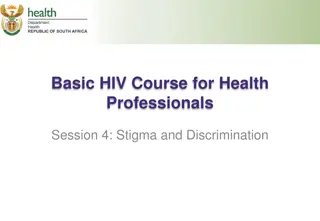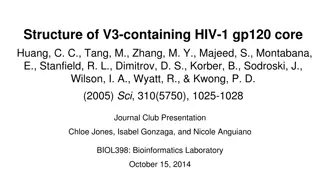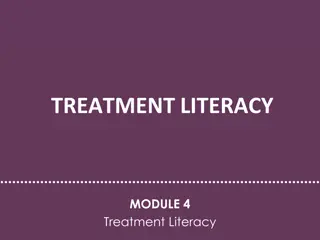Managing Drug Interactions and Side Effects in HIV/AIDS and Tuberculosis Therapies
Learn how to identify common therapies used in HIV/AIDS and TB treatment, understand drug-food interactions and side effects, and provide appropriate nutrition assessment and support to improve treatment outcomes. Service providers play a crucial role in addressing nutritional needs and managing drug-related complications for better health outcomes in special populations like undernourished clients and pregnant/lactating women with HIV.
Download Presentation

Please find below an Image/Link to download the presentation.
The content on the website is provided AS IS for your information and personal use only. It may not be sold, licensed, or shared on other websites without obtaining consent from the author. Download presentation by click this link. If you encounter any issues during the download, it is possible that the publisher has removed the file from their server.
E N D
Presentation Transcript
Integrating Nutrition Assessment, Counselling, and Support into Health Service Delivery Training Course for Facility-Based Health Providers Session 3.3 Using Diet to Manage Drug Interactions and Side Effects from Common Integrating Nutrition Assessment, Counselling, and Support into Health Service Delivery HIV/AIDS and Tuberculosis Therapies 1
Session Objectives By the end of the session, participants will be able to: Identify common therapies used by people living with HIV and TB Discuss drug-food interactions and side effects related to HIV and TB therapies Discuss drug-food interactions and side effects related to complementary and alternative medicines (CAM) Integrating Nutrition Assessment, Counselling, and Support into Health Service Delivery 2
Introduction PLHIV take medications to o Treat HIV (slowing progress) o Treat and reduce opportunistic infections o Reduce and ease symptoms o Treat other diseases/conditions Antiretroviral therapy (ART) o Simpler to administer than in previous years o More accessible than before o Potential to improve nutrition Integrating Nutrition Assessment, Counselling, and Support into Health Service Delivery 3
Introduction Drugs taken by PLHIV can: o Interact with certain foods and nutrients, affecting the drugs efficacy and clients adherence to the drugs o Create side effects that affect food intake and nutrient absorption and can also reduce adherence to medications Can lead to weight loss and undernutrition Service providers need to understand the food and nutrition implications and side effects of the drugs clients are taking and identify/implement appropriate responses. Integrating Nutrition Assessment, Counselling, and Support into Health Service Delivery 4
Note on Special Populations Service providers should be particularly attentive to: Undernourished clients initiating treatment o Increased risk of death so they need close monitoring o Food insecurity can prevent PLHIV from following food and nutrition recommendations. Help clients identify feasible alternative responses and when possible seek options to improve food security. Pregnant/lactating women with HIV o Have increased nutrition needs o Manage drug and food interactions promptly to protect health of mother and infant Integrating Nutrition Assessment, Counselling, and Support into Health Service Delivery 5
Common Therapies Used by PLHIV What are some common therapies (modern or traditional) used by people living with HIV in Uganda? Integrating Nutrition Assessment, Counselling, and Support into Health Service Delivery 6
Common Therapies Used by PLHIV PLHIV may use both traditional and modern therapies to treat HIV and opportunistic infections (OIs) and alleviate symptoms. Modern therapies o ARVs slow progression of HIV into disease o Main types of ARVs used in sub-Saharan Africa: Non-nucleoside reverse transcriptase inhibitors (NNRTI) Nucleoside/ nucleotide analogue reverse transcriptase inhibitors (NRTI) Protease inhibitors (PI) o Multiple ARVs are combined to enhance efficacy = HAART (highly active antiretroviral therapy) Integrating Nutrition Assessment, Counselling, and Support into Health Service Delivery 7
Common Therapies Used by PLHIV Other types of drugs taken by PLHIV include: o Antifungal drugs (e.g., Nystatin, Nizoral, and fluconazole) o TB therapy (e.g., Rifampin) o Antibiotic (Cotrimoxazole) as prophylaxis against PCP o Antimalarial drugs (e.g., Coartem, quinine) o Antihelminthic drugs (e.g., mebendazole, albendazole) to treat intestinal parasites and worms Integrating Nutrition Assessment, Counselling, and Support into Health Service Delivery 8
Common Therapies Used by PLHIV Traditional therapies: to alleviate symptoms and increase sense of hope and control over health problems o Herbs, teas, and infusions o Therapies vary from one place to another o Efficacy of most traditional therapies has not been well documented o Toxicity and effect on HIV infection generally are unknown o May interact with certain foods or other drugs o May have side effects Integrating Nutrition Assessment, Counselling, and Support into Health Service Delivery 9
Common Therapies Used by PLHIV Traditional and modern therapies often taken together Can interact with one another and with certain foods or have side effects, affecting drug efficacy and nutritional status o Some side effects/nutritional implications of traditional medicines known; others not known Service providers should help clients understand and manage interactions and side effects appropriately to: o Maximize the efficacy of therapies o Ensure interactions do not affect food intake, nutrient utilization, or adherence to drug regimens Integrating Nutrition Assessment, Counselling, and Support into Health Service Delivery 10
Drug-Food Interactions and Side Effects Critical parts of HIV care and treatment o Advising patients on drug-food interactions and side effects o Helping them to develop a nutrition care plan Nutrition care plans and strategies for managing interactions and side effects can: o Maximize the effectiveness of medical treatment o Prevent development of specific nutrient deficiencies o Optimize nutritional status, immunity, and overall well- being o Prevent and manage medication side effects that affect food intake or nutrient absorption o Prevent loss of weight and lean body mass Integrating Nutrition Assessment, Counselling, and Support into Health Service Delivery 11
Drug-Food Interactions and Side Effects Key recommendations for counselling clients on drug-food interactions and side effects Ask clients about all therapies (traditional and modern) they are taking. If clients are taking several drugs, consider the interactions of each drug and possible drug-drug interactions. Different drugs have different food interactions, so recommendations should be drug-specific. Recognize that all clients will not have the same response to medications. o Stay attentive and responsive to client-specific reactions. Integrating Nutrition Assessment, Counselling, and Support into Health Service Delivery 12
Drug-Food Interactions and Side Effects Involve the client fully in understanding interactions, identifying feasible responses, and adjusting or improving responses as needed. When possible, make sure that recommended dietary actions build on the client s practices and preferences. Integrating Nutrition Assessment, Counselling, and Support into Health Service Delivery 13
Impact of Food on Drug Efficacy Food can enhance or inhibit the absorption, metabolism, distribution, or excretion of certain drugs. Dietary practices to optimize drug efficacy should be based on the specific interactions of the drugs taken. Responses may include taking the drug with or without certain foods or on an empty stomach. Integrating Nutrition Assessment, Counselling, and Support into Health Service Delivery 14
Impact of Food on Drug Efficacy Service providers should help clients devise meal plan and drugs timetable. o Minimize food-drug interactions based on known effects of food on the drugs clients are taking. o Take into account drug-food interactions of each drug taken and the client s eating habits. Emphasize need to closely follow instructions for medication as prescribed and to continue the medication for its full course. Integrating Nutrition Assessment, Counselling, and Support into Health Service Delivery 15
Impact of Drugs on Nutrition Multiple ways that drugs can affect nutrition o Drugs can alter nutrient absorption, metabolism, distribution, or excretion, thereby affecting nutritional status. o Drug side effects can reduce food intake and absorption, and increase nutrient losses, thus impairing the body s ability to meet nutritional requirements. Dietary management may require o Taking a nutritional supplement o Altering food/nutrient intake o Devising strategies that help maintain food intake and compensate for nutrient losses Not all drug effects have a dietary solution (e.g., lipodystrophy). Integrating Nutrition Assessment, Counselling, and Support into Health Service Delivery 16
Impact of Drugs on Nutrition Metabolism of vitamins: o Isoniazid (anti-TB drug) inhibits vitamin B6 metabolism Vitamin B6 supplementation recommended o Rifampin (anti-TB drug), may interfere with vitamin D metabolism Vitamin D supplementation may be needed Integrating Nutrition Assessment, Counselling, and Support into Health Service Delivery 17
Impact of Drugs on Nutrition ARVs linked to: o Fat abnormalities (elevated triglycerides, cholesterol (dyslipidemia), and fat redistribution (lipodystrophy) o Glucose metabolism (dysglycaemia) o Bone disorders (osteoporosis, osteopeniaosteomalacia) Integrating Nutrition Assessment, Counselling, and Support into Health Service Delivery 18
Impact of Drugs on Nutrition Fat abnormalities: Elevated levels of triglycerides and cholesterol in the blood(dyslipidemia) Linked to increased risk of developing plaque or thickening of the arteries and increased risk of heart disease ARVs Saquinavir, Ritonavir Dietary and medical responses may be required o Increase fruit, vegetable, fibre intake o Increase omega-3 fatty aids from fish and plants and proportion of mono- and polyunsatured fats o Decrease refined carbohydrates and sugar, intake of saturated fats and trans-fats, cholesterol o Daily exercise o Avoid alcohol and smoking o Medication to lower lipid/cholesterol levels may be needed Integrating Nutrition Assessment, Counselling, and Support into Health Service Delivery 19
Impact of Drugs on Nutrition Lipodystrophy: disruption in production/utilization/distribution of fat o Body shape changes due to changes in fat distribution Effective management of lipodystrophy not yet established o Changes in ARV regimen may help o No evidence that dietary changes affect condition Integrating Nutrition Assessment, Counselling, and Support into Health Service Delivery 20
Impact of Drugs on Nutrition Dysglycaemia: abnormalities in blood glucose levels o Leads to insulin resistance, increased risk of diabetes Dietary management useful for mild cases: o Decreasing intake of refined carbohydrates, sugars, and saturated and trans-fats o Increasing exercise Moderate/severe cases may need insulin-sensitising agents/ insulin therapy Substituting PIs with non-protease inhibitors may also help Integrating Nutrition Assessment, Counselling, and Support into Health Service Delivery 21
Impact of Drugs on Nutrition Bone disorders: osteoporosis, osteopenia, osteomalacia o Dietary and medical responses may be required: Increasing intake of high-calcium foods (milk, yoghurt, cheese, green vegetables) Reducing intake of meat, fish, grains, legumes, nuts, sweet carbonated drinks, caffeine Reducing smoking Calcium and vitamin D supplements may be needed Integrating Nutrition Assessment, Counselling, and Support into Health Service Delivery 22
Impact of Drugs on Nutrition Side effects from drugs can result in reduced food intake and absorption, increased nutrient losses, leading to weight loss, malnutrition, and wasting. Side effects include: o Changes in taste o Loss of appetite (anorexia) o Nausea, bloating, and heartburn o Constipation o Vomiting and diarrhoea Integrating Nutrition Assessment, Counselling, and Support into Health Service Delivery 23
Impact of Drugs on Nutrition Strategies that help maintain food intake and compensate for nutrient losses from drug side effects o Adding spices/salt/sugar to enhance flavour and stimulate appetite or mask unpleasant flavours o Eating energy-rich and nutrient-dense foods and drinking plenty of liquids to replace nutrient losses and prevent dehydration o Eating small frequent meals for nausea o Preparing favourite foods and a variety of foods, avoiding strong smelling foods when appetite is poor Integrating Nutrition Assessment, Counselling, and Support into Health Service Delivery 24
Drug Side Effects Impact on Drug Adherence Side effects that cause a lot of discomfort or that prevent clients from eating properly can contribute to nonadherence to a drug regimen (many years for ARVs). Nonadherence can significantly worsen the health of PLHIV, speed progression of HIV, and even lead to drug-resistant strains of HIV, which are difficult or impossible to treat. o Patients should be counselled to closely follow instructions for medication as prescribed and to continue the medication for its full course. Managing side effects and other drug food interactions can help ensure adherence to drug regimens. Integrating Nutrition Assessment, Counselling, and Support into Health Service Delivery 25
Drug Side Effects Impact on Drug Adherence Nonadherence also can increase the incidence of OIs: o Drug side effects and OI symptoms are often difficult to distinguish from one another. o Patients should be counselled that not all symptoms are necessarily due to side effects of drugs. o Dietary strategies may alleviate these conditions if they are side effects; prompt medical treatment is necessary for infections, allergies, and other conditions. Integrating Nutrition Assessment, Counselling, and Support into Health Service Delivery 26
Resource Review Turn to Annex 1 at the end of the session in participant s guide. Review drug-food interaction table. Integrating Nutrition Assessment, Counselling, and Support into Health Service Delivery 27
Complementary and Alternative Medicine Complementary and alternative medicine (CAM): any treatment used in conjunction (complementary) or in place of (alternative) standard medical treatment. Includes: o Supplements/natural health products (including traditional medicines) Herbs, plants or parts of plants, or a combination of both (e.g., traditional and Chinese herbal medicines, Echinacea species, marijuana, goldenseal, aloe ) Nutritional supplements such as vitamins (commonly A, B6, B12, C, and E), beta carotene, acidophilus, garlic, zinc, ginseng, selenium, and coenzyme Q10 o Alternative therapies Acupuncture, massage, yoga, chiropractic treatment, mental imagery, meditation, qigong (an approach using breathing, movement, and meditation), therapeutic touch Integrating Nutrition Assessment, Counselling, and Support into Health Service Delivery 28
Complementary and Alternative Medicine Uganda: study of two centers of The Aids Support Organization (TAS) estimated CAM use at 33.7% CAM users were more likely to o Have been on HAART for < 4 years o Have experienced HAART side effects o Be 39 years o Have HAART adherence levels < 95%. Integrating Nutrition Assessment, Counselling, and Support into Health Service Delivery 29
Complementary and Alternative Medicine Interactions and side effects of traditional medicine and other forms of CAM It is important for health providers to ask about any CAM being used by their clients. Little is known about the effectiveness and drug interaction potential of traditional medicine and other types of CAM. o Can have adverse effects and side effects o Interactions between traditional herbal medicines and ARV drugs may result in increased toxicity and decreased efficacy of both o Some traditional herbal medicines may interact with foods to cause unhealthy side effects Lack of standardization of traditional medicines/natural health products Integrating Nutrition Assessment, Counselling, and Support into Health Service Delivery 30
Summary of Key Recommendations Service providers should be particularly attentive to any side effects and nutrition implications of ARVs among undernourished clients and pregnant and lactating women with HIV. If a client is taking several drugs, consider the interactions of each drug and possible drug-drug interactions. The nutrition implications of a drug combination may differ from the implications of the drugs individually. Because different drugs have different food interactions, recommendations should be drug-specific; understand the specific interactions of each drug used and counsel accordingly. Integrating Nutrition Assessment, Counselling, and Support into Health Service Delivery 31
Summary of Key Recommendations Recognize that all clients will not have the same response to medications. Clients taking the same drugs should not be treated the same. Stay attentive and responsive to client-specific reactions. If the client is taking traditional therapies, pay attention to their side effects and nutrition implications. Help clients who are using traditional therapies to identify side effects and interactions, as well as dietary responses that can help address them. Integrating Nutrition Assessment, Counselling, and Support into Health Service Delivery 32
Summary of Key Recommendations Involve the client fully in understanding interactions, identifying feasible responses, and adjusting or improving responses as needed. When possible, make sure that recommended dietary actions build on the client s practices and preferences. Integrating Nutrition Assessment, Counselling, and Support into Health Service Delivery 33
Thank you! Questions, additions, or clarifications? Integrating Nutrition Assessment, Counselling, and Support into Health Service Delivery 34
